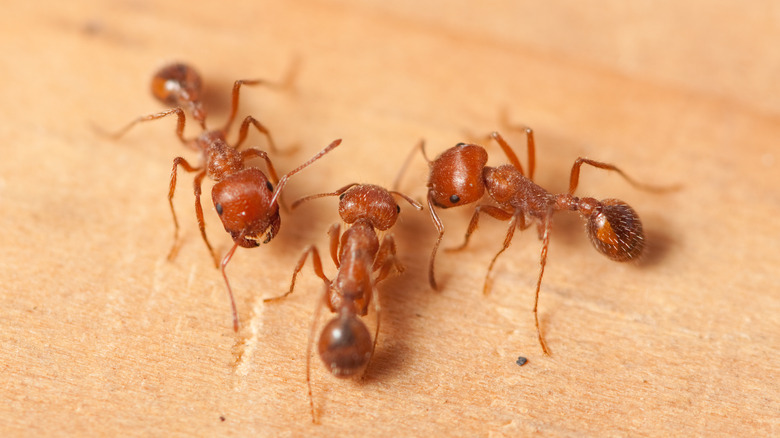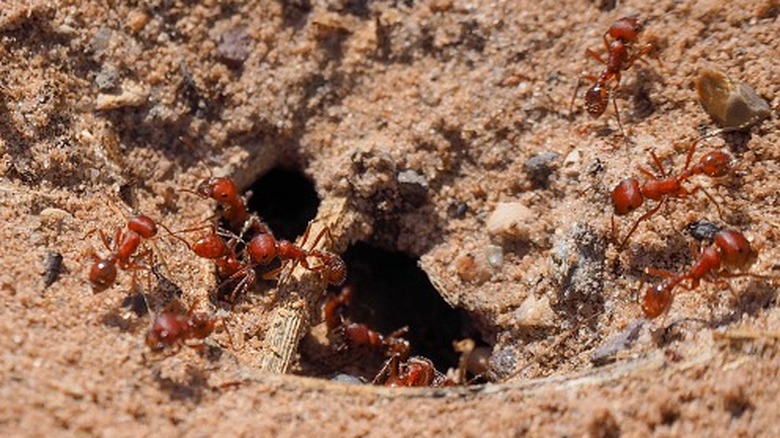What Happens When Fire Ants Attack Your Body, According To Science
Many play a childhood game called "Would you rather?" — as in, "Would you rather be bitten by fire ants or have a spider crawl across your face?" In late June 2023, the prospect of actual fire ant bites became no laughing matter when a 43-year-old Georgia woman named Cathy Weed died after she was bitten by the insects, according to her relatives. Shortly after she died, Weed's cause and manner of death were still pending. An autopsy was performed on her body, USA Today reports.
Though it sounds terrible, fire ant bites — really more like a combined bite and a sting — are not typically fatal. They generally result in painful, itchy bumps, blisters, and swelling in the area, but serious systemic reactions occur in some cases, causing vomiting and diarrhea, among other symptoms, per Cleveland Clinic. About 5% of the time, fire ant bites cause anaphylaxis, a life-threatening allergic reaction, ABC News reports. As entomologist Mike Raupp told ABC News, in anaphylaxis " ... throats swell up and people literally suffocate." Anaphylactic shock can also sometimes lead to cardiac arrest.
Fire ants are common in the southern US
Fire ants are common in most of California, parts of Southern Oregon and the Southwest, and the Southern U.S. states like Georgia where Cathy Weed lived, according to UCLA Health. When disturbed, fire ants attack in a combination of a bite and a sting, using their mandibles to attach themselves to human flesh while their stinger injects venom. When fire ants bite most people initially notice pain in the area similar to a bee sting followed by a burning sensation.
Within an hour or so the area where the person was stung will develop bumps that remain painful and itchy, and then become pus-filled blisters. Most often, reactions occur near where the bite happened, and the blisters caused by the bite typically clear up within a week to 10 days. Treatments include cleaning the area where the person was bitten, and then possibly antihistamines and hydrocortisone cream application.
According to entomologist Mike Raupp (via ABC News), fire ants live in mounds with a queen, and "if you bump into that nest, they will swarm out immediately and aggressively attack you, and no other ants will do that. There are no other stinging ants in North America," Raupp said, "so if you get stung by an ant, you can pretty much assume it's a fire ant." Those who may be having a severe medical reaction to fire ants should seek medical attention immediately.
Fire ants are spreading
As mentioned, fire ants — an invasive species in North America — live in warm climates but as temperatures rise, they've spread northward, WIRED reported in 2019. They also tend to cluster their nests around man-made irrigation. There are different species of fire ants, and some colonies can have up to 500 mounds per acre. These large populations seem to be a somewhat recent development as fire ants move into North America. Fire ants don't typically live in populations that large in other areas.
Some fire ants otherwise show amazing cooperation among their colony. In flooded areas, worker fire ants will cling together forming a flotation device of sorts. When those are disturbed the ants in float-formation still mobilize and attack, and fire ants typically sting more than once. According to Texas A&M University Agrilife Extension, some 14 million people are stung by fire ants each year. The best way to avoid a fire any sting is to watch where you walk where fire ants are known to live to steer clear when nests are encountered.


